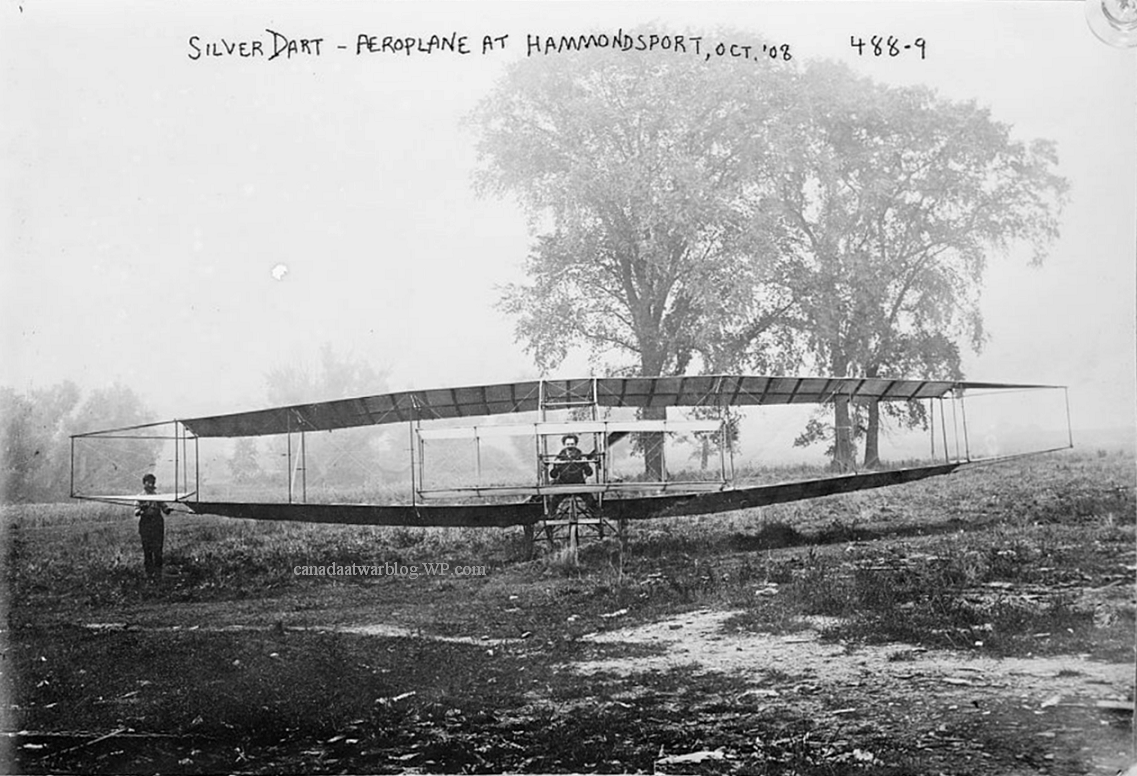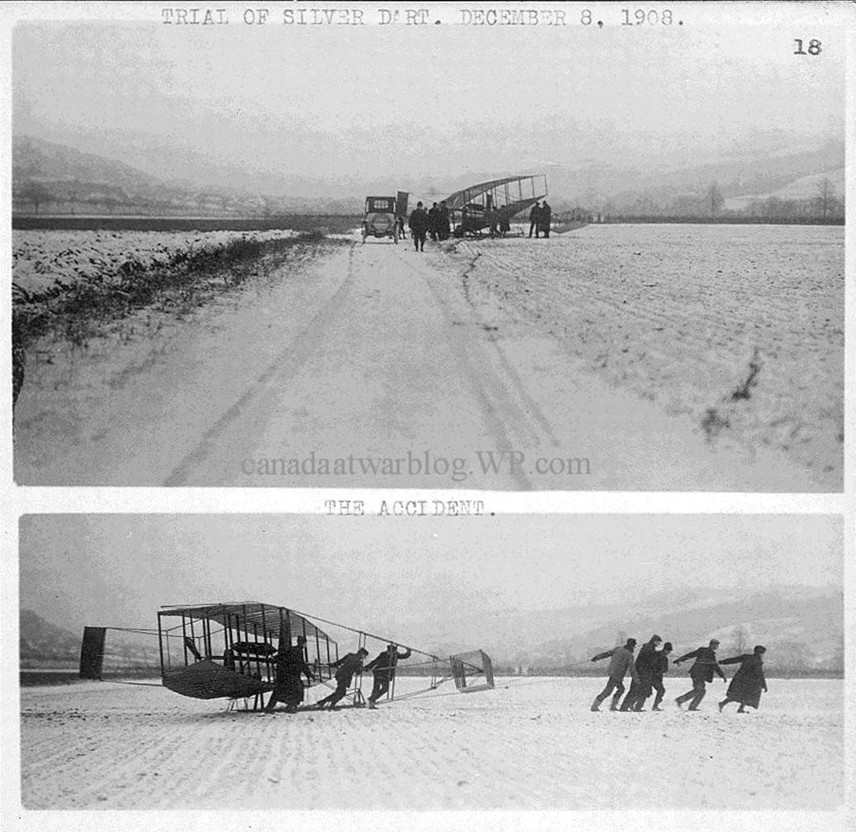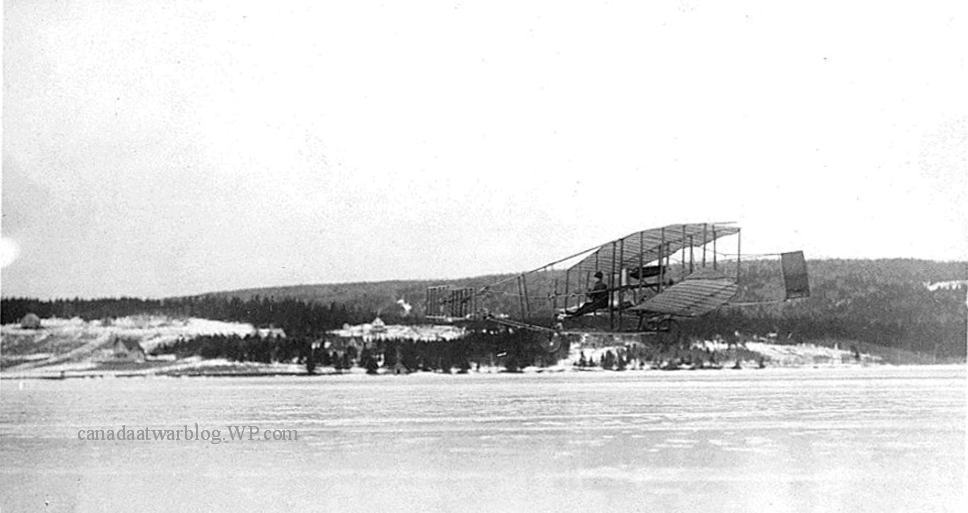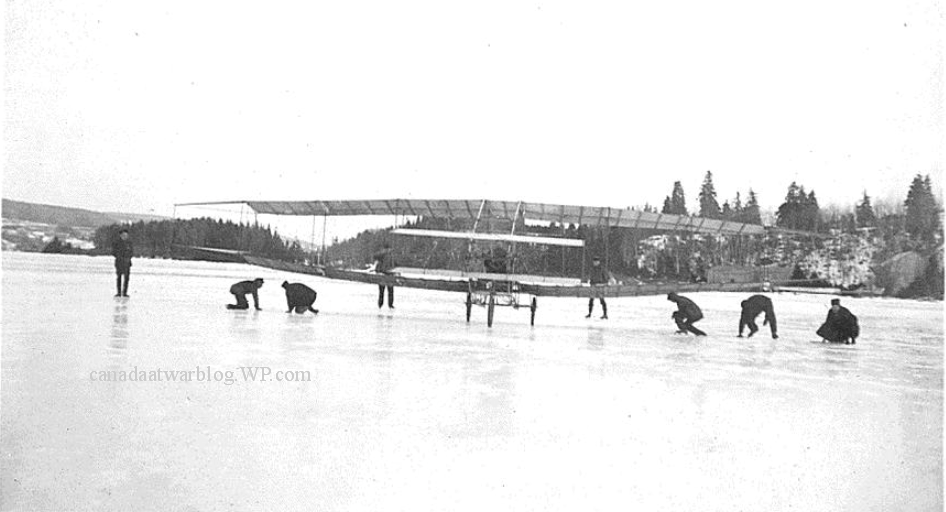- Reaction score
- 0
- Points
- 210
Hi: S.V.P. owing the comprehensive study paper, in maintaining Prof. Alec Bell’s high standards of principle, contains over 35,000 words, separating historian folklore from facts, divided into timeline chapters. Please note, instead of the DHH narrative persuading the Canadian government and militia in purchasing their aerodrome: I literally stumbled on the original letters, telegrams between all parties involved, complied and recorded, obviously by Dr. A.G. Bell, presently turning into text.
I’ll insert the intros too each one, for all those requiring a prime, documented, archived, sourced account, fallow short links: I can’t emphasis the amount of time and agitation, requiring a delicate touch, in compiling all this stuff, fallowing the bread crumbs in there proper sequence.

A.E.A.’s, J.A.D. McCurdy’s Silver Dart’s Birth at N.Y., July-Oct., 1908 Accounts of The Day. Part I. http://wp.me/p55eja-DZ
S.V.P. This is not your typical historian account; I certainly lack the required credentials, of a writer, academic or scholar, therefore Mr., Mrs., Bell & “Boys,” will narrate their own study-paper presentation. Alexander Graham Bell was a stickler in keeping records, constantly hounding McCurdy, Baldwin, Curtiss, Selfridge, on the importance in writing daily detailed accounts, photographing etc. Prof., Bell: “I am seriously troubled by the lack of proper records.” This was unveiled in Bell’s Deposition January 15, 1915, as he was questioned on the submitted, “Bulletin XXXIX, Souvenir Volume, April 12, 1909.” A score of times receiving unmarked photos, etc., Bell filled in the blanks by dating, entering received letters, telegrams, and photos. The latter sent from his summer estate, copies were produced, inserted in his personal "Beinn Bhreagh Recorder" and note book, as Curtiss and McCurdy dragged their heels in this matter. Prof. A.G. Bell: I call attention to the fact that the legend below the 201 photograph on page 5 shows the date “Dec 6, 1909” by error, instead of “Dec 6, 1907”, as stated correctly in the index to the volume. The famous recycled photo of Feb 23 as the Silver Dart took off the ice at baddeck bay is dated Feb 24 in two separate Volumes: Photo # 8 “Second flight of the Silver-Dart over the ice on Baddeck Bay not Feb 23. Feb. 24, 1909. McCurdy Aviator. Three photos. Upper picture, gives a near view of the Silver-Dart in the air (Feb.24) with McCurdy as aviator.” Photo # 28. Drome No. 4, McCurdy’s Silver-Dart, carrying Mr. J. A. Douglas McCurdy as Aviator, over the ice on Baddeck Bay, near Baddeck, Nova Scotia, Feb. 24, 1909. Furthermore, the three photos depiction of the Silver Dart accident at the racetrack dated Dec., 8, that event unfolded on December 9, 1908. While LAC’s photo PA-122520 inserts the proper date, they drop the ball on location: “Canada N.S. 9 Dec. 1908.”
The below only covers the title mentioned dates, extracted, timeline from the original bulletins, AEA’s members letters, telegrams, notes, etc. Owing too the size, amount of pages while at Stony Brook farm, H. Champlin’s half mile racetrack, H.Q. Hammodsport, N.Y., divided into two parts, July-Oct., Part I and Part II Nov.-Dec. Short- Link for: AEA’s J.A.D. McCurdy Silver Dart Accounts of The Day, Nov.-Dec., 1908. Part II. http://wp.me/p55eja-Eb
Milberry, Larry 1979; Casey, Louis S. 1981; Molson and Taylor 1982, vague narratives on AEA and Silver Dart, are perpetuated by mainstream historians/authors, online history; therefore questionable or factual? “Christened as the Silver Dart, after the metallic waterproofing,” although answers the Silver, noted only applied on one side of the wings, no mention why the word “Dart” was used. Letter from McCurdy to Mrs. Bell: N.Y., Aug. 30, 1908:— You ask me in your letter why we thought of the “Silver-Dart” as a name for aerodrome No. 4. Well the surfaces are silvered on one side, that suggested the “Silver”, and the word “Dart” will explain itself. Also the combination of the two words sounded rather attractive to me. McCurdy and Curtiss used the term “dart,” in reports, etc., prior to July, 1908, in description of the initial tail release of the aerodrome, as she quickly ran down the racetrack on Stony Brook Farm. Curtiss describing the flight of the “White Wing” on May 22:— The flyer was being held by the tail at the upper end of the back stretch of Harry Champlin’s half mile track on Stony Brook Farm. Upon being released she “darted forward” and sped down the track at a speed of perhaps 25 miles per hour.
Letter from Alexander Graham Bell to J.A.D. McCurdy, 1331 Connecticut Avenue, Washington, D.C. March 17, 1908. Mr. J. A. Douglas McCurdy, c/o of G. H. Curtiss Co., Hammondsport, New York. Dear Douglas:— I think it very important that you should make every effort to keep a photographic record of what is being done at Hammondsport, on the same general plan as the record you kept at Beinn Bhreagh. The photographs sent by Mr. Curtiss would not be sufficient as evidence of diligence and invention, for they bear no identifying mark, they have no date, and they are kept in the hands of the experimenters themselves…Now my dear fellow do look after this for the importance of the photographic record is greater than you have any conception of. Sometime or other litigation on flying machine inventions will arise and I am seriously troubled by the lack of proper records. http://www.loc.gov/resource/magbell.14800301

A.E.A.’s, J.A.D. McCurdy Silver Dart Accounts of The Day, Nov.-Dec., 1908. Part II. http://wp.me/p55eja-Eb
Mainstream accounts on Aerial Experiment Association Drome No. 4, McCurdy’s Silver Dart first flight are properly dated. However out of the first 3 starts, one developed into a short-flight at the racetrack, Dec., 6th 1908, although the amounts of “flights” at Stony Brook Farm, N.Y., are misleading. The status quo accounts claim 10 successful flights took place, confusingly petawawamuseums.ca, using military styled dating: “The Silver Dart first took to the air in Hammondsport on 06 December 1908, and flew ten more times before the turkey was served on Christmas Day that year.” While the latter suggests 11, some account state 14 flights occurred by the time the Dart was dismantled and crated. Transported to Bell’s laboratory at “Beinn Bhreagh” estate, overlooking Bras d’Or Lake, across the bay, facing the village of Baddeck, sent on Jan., 6th 1909 from NY. For AEA the term “start” vs “flight” is; a “start” represents going down the track reaching 150 ft., gently rising several feet off the ground. Maintaining flight, covering distances from 50-200 yards, at this point turning off the engine and gliding for a landing, at times the distances were shorter: McCurdy also used the term “short hops.” A “flight” consisted going over that point, reaching much higher and longer distances, not forgetting McCurdy & Curtiss’ acknowledgment, a good portion were “short-flights.” “Three starts were made down the track in the usual manner, the machine rising gently from the ground after covering a distance of about 150 ft…… On Sunday we had three starts all of about 200 yards, the machine dropping of her own accord on account of insufficient theoretical speed in advance of the propeller.”
Note, at the end of this paper, I will provide the amount of “starts,” failed attempts, short flights, and flights, recorded while at Stony Brook farm, ½ mile racetrack, near Hammodsport, N.Y., or just fallow the timeline and keep count.
Although always speculated, I only recently uncovered why Prof. Bell christen AEA’s flying machines as aerodromes, the latter of part II will provided Bell’s December 29th 1908 account.

A.E.A.’s, J.A.D. McCurdy’s Silver Dart Cases Held Hostage at Iona NS, Awaiting $425.00 Payment. http://wp.me/p55eja-Ep
The original registered documents of the day reveals: Canada Customs never prevented AEA’s aerodrome No. 4 Silver Dart, from entering Canada, or any brief incident with import duties at the border, occurred. The Village of Baddeck, from conception was without a mayor, while the Premier of Nova Scotia, George Henry Murray, never led Canadian authorities too vastly reduce the import tariff on the aerodrome. If historians had taken the time in conducting the proper leg work, they would’ve uncovered the facts. Acknowledged by Victoria County Heritage & Archives:— “Prior April 1851 part of Cape Breton County, proclaimed Victoria County designated as a rural municipality with a Warden and Councillor system. Organised the first assembly styled as
“Court of Sessions,” with eleven “Justices of the Peace,” among them elected a “Custos Rotulorum,” establishing the “county’s seat,” (H.Q.) at Baddeck. In 1879, the Province passed the “Rural Municipalities Act” which instituted the form of municipal government as it is at the present time, with Councillors from each district and an elected Warden. The first Municipal Council session was held in January, 1880, and it consisted of sixteen Councillors from the various districts of the County. The first Warden elected by Council was Dr. John L. Bethune, a resident of the Village of Baddeck. The elected warden for 1909 was John M. Buchanan representing District 4 (South Gut); the councillor for the Village of Baddeck was Murdoch D. MacAskill: Only towns and cities have ‘mayors’ and councillors.”
A.G. Bell’s press despatches, bulletins etc., declared Canadians would soon witness aviation history, Baddeck residents, and others “very anxious,” when cases of the flying machine arrived. This prompted Baddeck resident Kenneth J. McKay, a prominent respected businessman, partnered in MacKay, MacAskill general store on Main Street, to cable from the Telegraph House. Telegram to Hon. Mr. Patterson, Minister of Customs, Ottawa, Canada:— Citizens Baddeck very anxious that you allow free entry on experimental flying machine and apparatus for Dr. Graham Bell which arrived last night. The Minister hastily responded:— Have written Collector Baddeck respecting admission flying machine…. that there shall be no duty charged if machine is returned within two years.
The Dart was first delayed by the weather, as McCurdy pondered, awaiting favourable conditions for trials, and underestimating time required in the construction of wooden cases and boxes: “Fête sur mesure.” Curtiss on Jan 6th 1909 transported No. 4 Drome by express rail, informed after reaching Bath his “over size package” would be transported by “freight as far as Niagara Falls.” Curtiss informed Prof. Bell on Jan 9th of this matter further adding: If the Canadian Express cars will accommodate it, it will go by express from there, otherwise it will go all the way through by freight.
A few examples of mainstream historian’s narratives as fallows:—
Although Canada Customs originally prevented the Silver Dart from entering the country, an urgent request from Baddeck convinced them to allow it duty-free entry with the condition that the aircraft not remain in the county more than two years.
http://www.427wing.com/TheLink/07082015LondonLink.pdf
The aerodrome was shipped via rail from Hammondsport through Buffalo, NY to the international bridge crossing at Niagara Falls. From there it proceeded by rail to Nova Scotia after a brief incident with import duties at the border. Intervention from the Mayor of Baddeck and the Premier of Nova Scotia led Canadian authorities to vastly reduce the import tariff on the aircraft and it was on its way to a rendezvous with history. http://best-breezes.squarespace.com/the-silver-dart-aerodrome-4/
At first McCurdy and Bell, informed by Curtiss, assumed the missing cases were, “stalled somewhere either at the border, or at Montreal.” McCurdy’s Silver Dart cases held hostage at Iona NS, awaiting $425.00 payment for “expressage special car.” J. Price to Agent Iona Montreal, Jan. 25, 1909:— Graham Bell should pay car load rate Suspension Bridge to Iona, account special car used all the way through, boxes being too large for regular car. With back and forth wrangling, the remaining Silver-Dart crates arrived on Feb. 6, the engine, morning of Feb. 11, 1909.
.
I’ll insert the intros too each one, for all those requiring a prime, documented, archived, sourced account, fallow short links: I can’t emphasis the amount of time and agitation, requiring a delicate touch, in compiling all this stuff, fallowing the bread crumbs in there proper sequence.

A.E.A.’s, J.A.D. McCurdy’s Silver Dart’s Birth at N.Y., July-Oct., 1908 Accounts of The Day. Part I. http://wp.me/p55eja-DZ
S.V.P. This is not your typical historian account; I certainly lack the required credentials, of a writer, academic or scholar, therefore Mr., Mrs., Bell & “Boys,” will narrate their own study-paper presentation. Alexander Graham Bell was a stickler in keeping records, constantly hounding McCurdy, Baldwin, Curtiss, Selfridge, on the importance in writing daily detailed accounts, photographing etc. Prof., Bell: “I am seriously troubled by the lack of proper records.” This was unveiled in Bell’s Deposition January 15, 1915, as he was questioned on the submitted, “Bulletin XXXIX, Souvenir Volume, April 12, 1909.” A score of times receiving unmarked photos, etc., Bell filled in the blanks by dating, entering received letters, telegrams, and photos. The latter sent from his summer estate, copies were produced, inserted in his personal "Beinn Bhreagh Recorder" and note book, as Curtiss and McCurdy dragged their heels in this matter. Prof. A.G. Bell: I call attention to the fact that the legend below the 201 photograph on page 5 shows the date “Dec 6, 1909” by error, instead of “Dec 6, 1907”, as stated correctly in the index to the volume. The famous recycled photo of Feb 23 as the Silver Dart took off the ice at baddeck bay is dated Feb 24 in two separate Volumes: Photo # 8 “Second flight of the Silver-Dart over the ice on Baddeck Bay not Feb 23. Feb. 24, 1909. McCurdy Aviator. Three photos. Upper picture, gives a near view of the Silver-Dart in the air (Feb.24) with McCurdy as aviator.” Photo # 28. Drome No. 4, McCurdy’s Silver-Dart, carrying Mr. J. A. Douglas McCurdy as Aviator, over the ice on Baddeck Bay, near Baddeck, Nova Scotia, Feb. 24, 1909. Furthermore, the three photos depiction of the Silver Dart accident at the racetrack dated Dec., 8, that event unfolded on December 9, 1908. While LAC’s photo PA-122520 inserts the proper date, they drop the ball on location: “Canada N.S. 9 Dec. 1908.”
The below only covers the title mentioned dates, extracted, timeline from the original bulletins, AEA’s members letters, telegrams, notes, etc. Owing too the size, amount of pages while at Stony Brook farm, H. Champlin’s half mile racetrack, H.Q. Hammodsport, N.Y., divided into two parts, July-Oct., Part I and Part II Nov.-Dec. Short- Link for: AEA’s J.A.D. McCurdy Silver Dart Accounts of The Day, Nov.-Dec., 1908. Part II. http://wp.me/p55eja-Eb
Milberry, Larry 1979; Casey, Louis S. 1981; Molson and Taylor 1982, vague narratives on AEA and Silver Dart, are perpetuated by mainstream historians/authors, online history; therefore questionable or factual? “Christened as the Silver Dart, after the metallic waterproofing,” although answers the Silver, noted only applied on one side of the wings, no mention why the word “Dart” was used. Letter from McCurdy to Mrs. Bell: N.Y., Aug. 30, 1908:— You ask me in your letter why we thought of the “Silver-Dart” as a name for aerodrome No. 4. Well the surfaces are silvered on one side, that suggested the “Silver”, and the word “Dart” will explain itself. Also the combination of the two words sounded rather attractive to me. McCurdy and Curtiss used the term “dart,” in reports, etc., prior to July, 1908, in description of the initial tail release of the aerodrome, as she quickly ran down the racetrack on Stony Brook Farm. Curtiss describing the flight of the “White Wing” on May 22:— The flyer was being held by the tail at the upper end of the back stretch of Harry Champlin’s half mile track on Stony Brook Farm. Upon being released she “darted forward” and sped down the track at a speed of perhaps 25 miles per hour.
Letter from Alexander Graham Bell to J.A.D. McCurdy, 1331 Connecticut Avenue, Washington, D.C. March 17, 1908. Mr. J. A. Douglas McCurdy, c/o of G. H. Curtiss Co., Hammondsport, New York. Dear Douglas:— I think it very important that you should make every effort to keep a photographic record of what is being done at Hammondsport, on the same general plan as the record you kept at Beinn Bhreagh. The photographs sent by Mr. Curtiss would not be sufficient as evidence of diligence and invention, for they bear no identifying mark, they have no date, and they are kept in the hands of the experimenters themselves…Now my dear fellow do look after this for the importance of the photographic record is greater than you have any conception of. Sometime or other litigation on flying machine inventions will arise and I am seriously troubled by the lack of proper records. http://www.loc.gov/resource/magbell.14800301

A.E.A.’s, J.A.D. McCurdy Silver Dart Accounts of The Day, Nov.-Dec., 1908. Part II. http://wp.me/p55eja-Eb
Mainstream accounts on Aerial Experiment Association Drome No. 4, McCurdy’s Silver Dart first flight are properly dated. However out of the first 3 starts, one developed into a short-flight at the racetrack, Dec., 6th 1908, although the amounts of “flights” at Stony Brook Farm, N.Y., are misleading. The status quo accounts claim 10 successful flights took place, confusingly petawawamuseums.ca, using military styled dating: “The Silver Dart first took to the air in Hammondsport on 06 December 1908, and flew ten more times before the turkey was served on Christmas Day that year.” While the latter suggests 11, some account state 14 flights occurred by the time the Dart was dismantled and crated. Transported to Bell’s laboratory at “Beinn Bhreagh” estate, overlooking Bras d’Or Lake, across the bay, facing the village of Baddeck, sent on Jan., 6th 1909 from NY. For AEA the term “start” vs “flight” is; a “start” represents going down the track reaching 150 ft., gently rising several feet off the ground. Maintaining flight, covering distances from 50-200 yards, at this point turning off the engine and gliding for a landing, at times the distances were shorter: McCurdy also used the term “short hops.” A “flight” consisted going over that point, reaching much higher and longer distances, not forgetting McCurdy & Curtiss’ acknowledgment, a good portion were “short-flights.” “Three starts were made down the track in the usual manner, the machine rising gently from the ground after covering a distance of about 150 ft…… On Sunday we had three starts all of about 200 yards, the machine dropping of her own accord on account of insufficient theoretical speed in advance of the propeller.”
Note, at the end of this paper, I will provide the amount of “starts,” failed attempts, short flights, and flights, recorded while at Stony Brook farm, ½ mile racetrack, near Hammodsport, N.Y., or just fallow the timeline and keep count.
Although always speculated, I only recently uncovered why Prof. Bell christen AEA’s flying machines as aerodromes, the latter of part II will provided Bell’s December 29th 1908 account.

A.E.A.’s, J.A.D. McCurdy’s Silver Dart Cases Held Hostage at Iona NS, Awaiting $425.00 Payment. http://wp.me/p55eja-Ep
The original registered documents of the day reveals: Canada Customs never prevented AEA’s aerodrome No. 4 Silver Dart, from entering Canada, or any brief incident with import duties at the border, occurred. The Village of Baddeck, from conception was without a mayor, while the Premier of Nova Scotia, George Henry Murray, never led Canadian authorities too vastly reduce the import tariff on the aerodrome. If historians had taken the time in conducting the proper leg work, they would’ve uncovered the facts. Acknowledged by Victoria County Heritage & Archives:— “Prior April 1851 part of Cape Breton County, proclaimed Victoria County designated as a rural municipality with a Warden and Councillor system. Organised the first assembly styled as
“Court of Sessions,” with eleven “Justices of the Peace,” among them elected a “Custos Rotulorum,” establishing the “county’s seat,” (H.Q.) at Baddeck. In 1879, the Province passed the “Rural Municipalities Act” which instituted the form of municipal government as it is at the present time, with Councillors from each district and an elected Warden. The first Municipal Council session was held in January, 1880, and it consisted of sixteen Councillors from the various districts of the County. The first Warden elected by Council was Dr. John L. Bethune, a resident of the Village of Baddeck. The elected warden for 1909 was John M. Buchanan representing District 4 (South Gut); the councillor for the Village of Baddeck was Murdoch D. MacAskill: Only towns and cities have ‘mayors’ and councillors.”
A.G. Bell’s press despatches, bulletins etc., declared Canadians would soon witness aviation history, Baddeck residents, and others “very anxious,” when cases of the flying machine arrived. This prompted Baddeck resident Kenneth J. McKay, a prominent respected businessman, partnered in MacKay, MacAskill general store on Main Street, to cable from the Telegraph House. Telegram to Hon. Mr. Patterson, Minister of Customs, Ottawa, Canada:— Citizens Baddeck very anxious that you allow free entry on experimental flying machine and apparatus for Dr. Graham Bell which arrived last night. The Minister hastily responded:— Have written Collector Baddeck respecting admission flying machine…. that there shall be no duty charged if machine is returned within two years.
The Dart was first delayed by the weather, as McCurdy pondered, awaiting favourable conditions for trials, and underestimating time required in the construction of wooden cases and boxes: “Fête sur mesure.” Curtiss on Jan 6th 1909 transported No. 4 Drome by express rail, informed after reaching Bath his “over size package” would be transported by “freight as far as Niagara Falls.” Curtiss informed Prof. Bell on Jan 9th of this matter further adding: If the Canadian Express cars will accommodate it, it will go by express from there, otherwise it will go all the way through by freight.
A few examples of mainstream historian’s narratives as fallows:—
Although Canada Customs originally prevented the Silver Dart from entering the country, an urgent request from Baddeck convinced them to allow it duty-free entry with the condition that the aircraft not remain in the county more than two years.
http://www.427wing.com/TheLink/07082015LondonLink.pdf
The aerodrome was shipped via rail from Hammondsport through Buffalo, NY to the international bridge crossing at Niagara Falls. From there it proceeded by rail to Nova Scotia after a brief incident with import duties at the border. Intervention from the Mayor of Baddeck and the Premier of Nova Scotia led Canadian authorities to vastly reduce the import tariff on the aircraft and it was on its way to a rendezvous with history. http://best-breezes.squarespace.com/the-silver-dart-aerodrome-4/
At first McCurdy and Bell, informed by Curtiss, assumed the missing cases were, “stalled somewhere either at the border, or at Montreal.” McCurdy’s Silver Dart cases held hostage at Iona NS, awaiting $425.00 payment for “expressage special car.” J. Price to Agent Iona Montreal, Jan. 25, 1909:— Graham Bell should pay car load rate Suspension Bridge to Iona, account special car used all the way through, boxes being too large for regular car. With back and forth wrangling, the remaining Silver-Dart crates arrived on Feb. 6, the engine, morning of Feb. 11, 1909.
.




